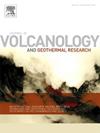Hydrogeochemical characterization of mineral waters from Fogo Volcano (São Miguel, Azores)
IF 2.3
3区 地球科学
Q2 GEOSCIENCES, MULTIDISCIPLINARY
Journal of Volcanology and Geothermal Research
Pub Date : 2025-04-27
DOI:10.1016/j.jvolgeores.2025.108348
引用次数: 0
Abstract
Mineral waters discharges of Fogo volcano (São Miguel Island, Azores) present a wide range of physico–chemical characteristics. These discharges may be divided into thermal waters, with temperatures as high as 58.4 °C and some with acidic pH (2.4–3.3), and cold waters, some of them with high dissolved CO2 concentrations (maximum value = 1028 mg.L−1). There is a negative correlation between pH and temperature, ascribed to volcanic input, and a positive correlation between electrical conductivity and the concentration in HCO3, usually associated with rock weathering. These waters do not exhibit a significant seasonal variation of the major components and physico–chemical parameters. Nevertheless, rare earth elements and 87Sr/86Sr ratios point to an incongruent dissolution of the rock, with some samples depicting a seasonal influence, which is related to different proportions of rock weathering. Based on the analyzed samples and the subsurface geology, it was possible to distinguish different perched–aquifers systems in Fogo, associated to lava flows sequences. Caldeiras da Ribeira Grande is characterized by thermal and acid–sulfate waters, and Lombadas presents a shallower aquifer system, with high CO2 influx and higher concentrations of rock–forming elements.
亚速尔群岛Fogo火山(s o Miguel)矿泉水水文地球化学特征
亚速尔群岛米格尔岛福戈火山喷出的矿泉水具有广泛的物理化学特征。这些排放物可分为温度高达58.4°C的热水和酸性pH值(2.4-3.3)的冷水,其中一些具有高溶解CO2浓度(最大值= 1028 mg.L−1)。pH值与温度呈负相关,归因于火山输入;电导率与HCO3浓度呈正相关,通常与岩石风化有关。这些水域的主要成分和理化参数没有明显的季节变化。然而,稀土元素和87Sr/86Sr比值表明岩石的溶解不一致,一些样品显示了季节的影响,这与岩石风化的不同比例有关。根据分析的样品和地下地质情况,可以区分与熔岩流序列相关的Fogo不同的栖息含水层系统。Caldeiras da Ribeira Grande以热水和酸性硫酸盐水为特征,而Lombadas则呈现出较浅的含水层系统,具有高CO2流入和较高浓度的岩石形成元素。
本文章由计算机程序翻译,如有差异,请以英文原文为准。
求助全文
约1分钟内获得全文
求助全文
来源期刊
CiteScore
5.90
自引率
13.80%
发文量
183
审稿时长
19.7 weeks
期刊介绍:
An international research journal with focus on volcanic and geothermal processes and their impact on the environment and society.
Submission of papers covering the following aspects of volcanology and geothermal research are encouraged:
(1) Geological aspects of volcanic systems: volcano stratigraphy, structure and tectonic influence; eruptive history; evolution of volcanic landforms; eruption style and progress; dispersal patterns of lava and ash; analysis of real-time eruption observations.
(2) Geochemical and petrological aspects of volcanic rocks: magma genesis and evolution; crystallization; volatile compositions, solubility, and degassing; volcanic petrography and textural analysis.
(3) Hydrology, geochemistry and measurement of volcanic and hydrothermal fluids: volcanic gas emissions; fumaroles and springs; crater lakes; hydrothermal mineralization.
(4) Geophysical aspects of volcanic systems: physical properties of volcanic rocks and magmas; heat flow studies; volcano seismology, geodesy and remote sensing.
(5) Computational modeling and experimental simulation of magmatic and hydrothermal processes: eruption dynamics; magma transport and storage; plume dynamics and ash dispersal; lava flow dynamics; hydrothermal fluid flow; thermodynamics of aqueous fluids and melts.
(6) Volcano hazard and risk research: hazard zonation methodology, development of forecasting tools; assessment techniques for vulnerability and impact.

 求助内容:
求助内容: 应助结果提醒方式:
应助结果提醒方式:


